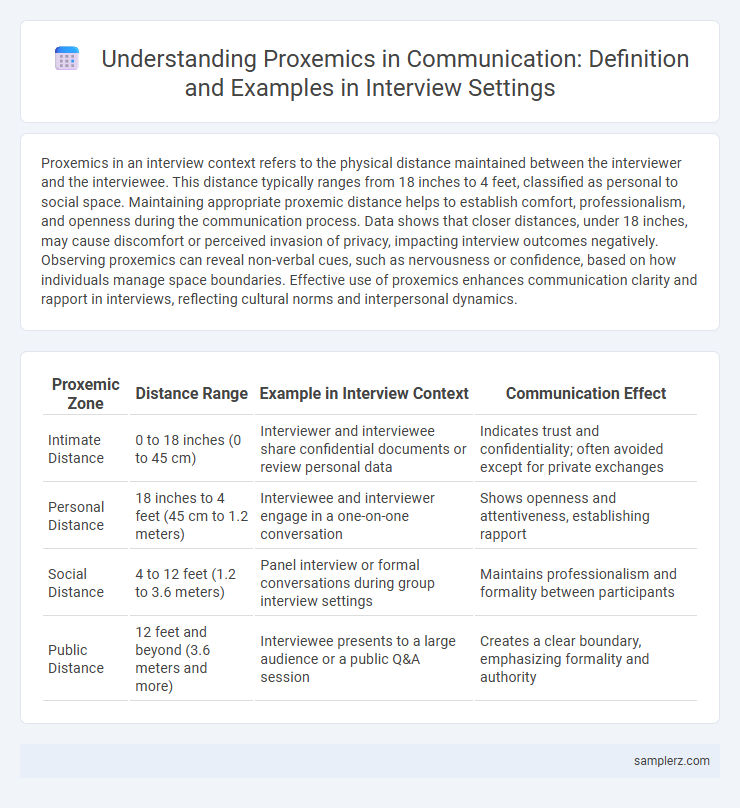Proxemics in an interview context refers to the physical distance maintained between the interviewer and the interviewee. This distance typically ranges from 18 inches to 4 feet, classified as personal to social space. Maintaining appropriate proxemic distance helps to establish comfort, professionalism, and openness during the communication process. Data shows that closer distances, under 18 inches, may cause discomfort or perceived invasion of privacy, impacting interview outcomes negatively. Observing proxemics can reveal non-verbal cues, such as nervousness or confidence, based on how individuals manage space boundaries. Effective use of proxemics enhances communication clarity and rapport in interviews, reflecting cultural norms and interpersonal dynamics.
Table of Comparison
| Proxemic Zone | Distance Range | Example in Interview Context | Communication Effect |
|---|---|---|---|
| Intimate Distance | 0 to 18 inches (0 to 45 cm) | Interviewer and interviewee share confidential documents or review personal data | Indicates trust and confidentiality; often avoided except for private exchanges |
| Personal Distance | 18 inches to 4 feet (45 cm to 1.2 meters) | Interviewee and interviewer engage in a one-on-one conversation | Shows openness and attentiveness, establishing rapport |
| Social Distance | 4 to 12 feet (1.2 to 3.6 meters) | Panel interview or formal conversations during group interview settings | Maintains professionalism and formality between participants |
| Public Distance | 12 feet and beyond (3.6 meters and more) | Interviewee presents to a large audience or a public Q&A session | Creates a clear boundary, emphasizing formality and authority |
Understanding Proxemics in Interview Settings
In interview settings, proxemics involves managing the physical distance between the interviewer and the interviewee to foster comfort and effective communication. Maintaining an appropriate personal space of about 18 to 24 inches helps build rapport and reduces anxiety during the interview process. Understanding cultural variations in proxemic preferences is essential for interviewers to avoid misunderstandings and create a positive interaction environment.
The Role of Personal Space During Interviews
Personal space significantly influences communication dynamics in interviews, where maintaining an appropriate distance of 18 to 48 inches promotes comfort and professionalism. Invading this proxemic boundary may cause discomfort, reduce openness, and hinder effective information exchange between interviewer and interviewee. Understanding and respecting personal space fosters a positive atmosphere conducive to trust and honest dialogue.
Examples of Distance Zones in Interview Rooms
Interview rooms often feature distinct proxemic zones, such as intimate distance (0-18 inches) for close, confidential discussions and personal distance (18 inches to 4 feet) for formal exchanges. Social distance (4 to 12 feet) is commonly maintained during initial interviews to promote professional boundaries and comfort. These spatial arrangements influence nonverbal communication, affecting interviewee anxiety and rapport building.
How Seating Arrangements Affect Interview Dynamics
Seating arrangements in interviews significantly influence proxemics by shaping interpersonal distance and perceived power dynamics. Face-to-face seating promotes direct engagement and effective verbal and nonverbal communication, while side-by-side arrangements can reduce tension and foster collaboration. Circular seating reduces hierarchical gaps, encouraging openness and mutual respect during the interview process.
Proxemic Cues: Reading Body Language and Space
Proxemic cues in interviews include the distance maintained between the interviewer and interviewee, which typically ranges from 1.5 to 4 feet, indicating a professional yet approachable interaction. Observing body orientation and posture, such as leaning slightly forward or keeping shoulders open, signals engagement and attentiveness. Interpreting these spatial and nonverbal signals enhances understanding of comfort levels and rapport during communication.
Adjusting Proxemics for Virtual Interviews
Adjusting proxemics in virtual interviews involves managing personal space cues through camera framing, ensuring a medium distance that mimics face-to-face interactions. Positioning the camera at eye level creates a sense of direct engagement and conveys attentiveness. Controlling background elements and lighting enhances nonverbal communication, compensating for the lack of physical proximity.
Cultural Variations in Proxemics During Interviews
Cultural variations in proxemics during interviews significantly influence personal space and body language, affecting communication effectiveness. For instance, in Latin American cultures, close physical proximity and direct eye contact are common, whereas in East Asian cultures, maintaining a greater distance and indirect gaze is preferred to show respect. Understanding these cultural differences helps interviewers and candidates navigate conversations smoothly, fostering mutual respect and reducing misunderstandings.
Employer vs. Candidate: Power Dynamics and Space
In interviews, proxemics reveal power dynamics as employers often occupy larger, more authoritative spaces, such as sitting behind desks, while candidates position themselves in less dominant areas, highlighting hierarchy. Physical distance maintained by employers can underscore control and formality, whereas candidates tend to adopt a more submissive posture within the limited proxemic space. Understanding these spatial arrangements helps decode nonverbal cues related to dominance, intimidation, and engagement during the hiring process.
Impact of Proxemics on Interview Outcomes
Proxemics significantly influences interview outcomes by shaping the emotional tone and level of comfort between interviewer and candidate. Maintaining appropriate interpersonal distance enhances trust, reduces anxiety, and fosters open communication, leading to more accurate assessments. Mismanagement of personal space can create discomfort, hinder rapport, and negatively affect the candidate's performance and the interviewer's perception.
Tips for Managing Proxemics in Professional Interviews
Maintaining appropriate physical distance during professional interviews communicates respect and attentiveness, typically about 18 to 24 inches for personal space. Positioning yourself at a slight angle rather than directly face-to-face can reduce tension and promote a comfortable atmosphere. Observing the interviewer's body language helps adjust your proxemics to ensure a positive, engaging interaction.

example of proxemic in interview Infographic
 samplerz.com
samplerz.com